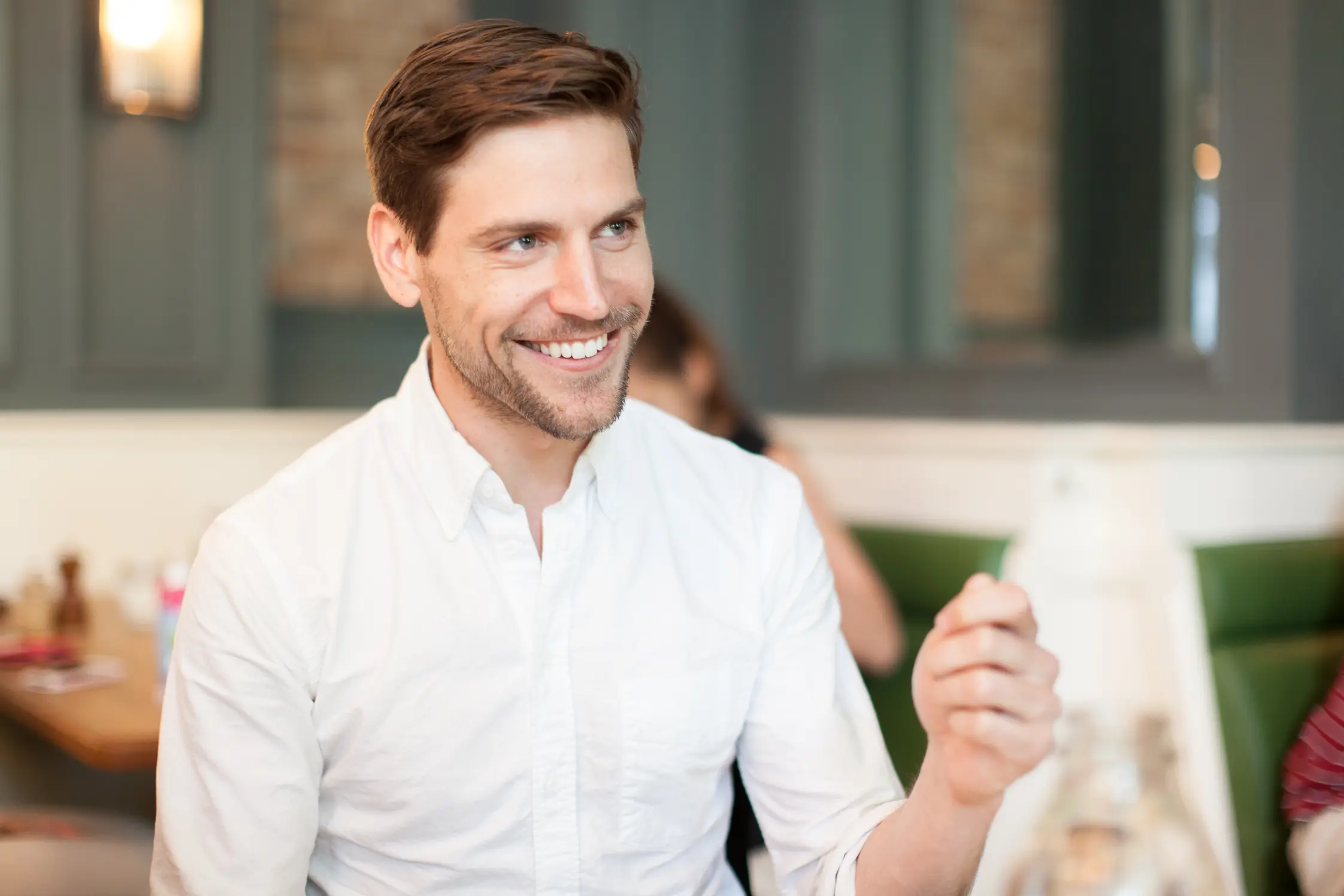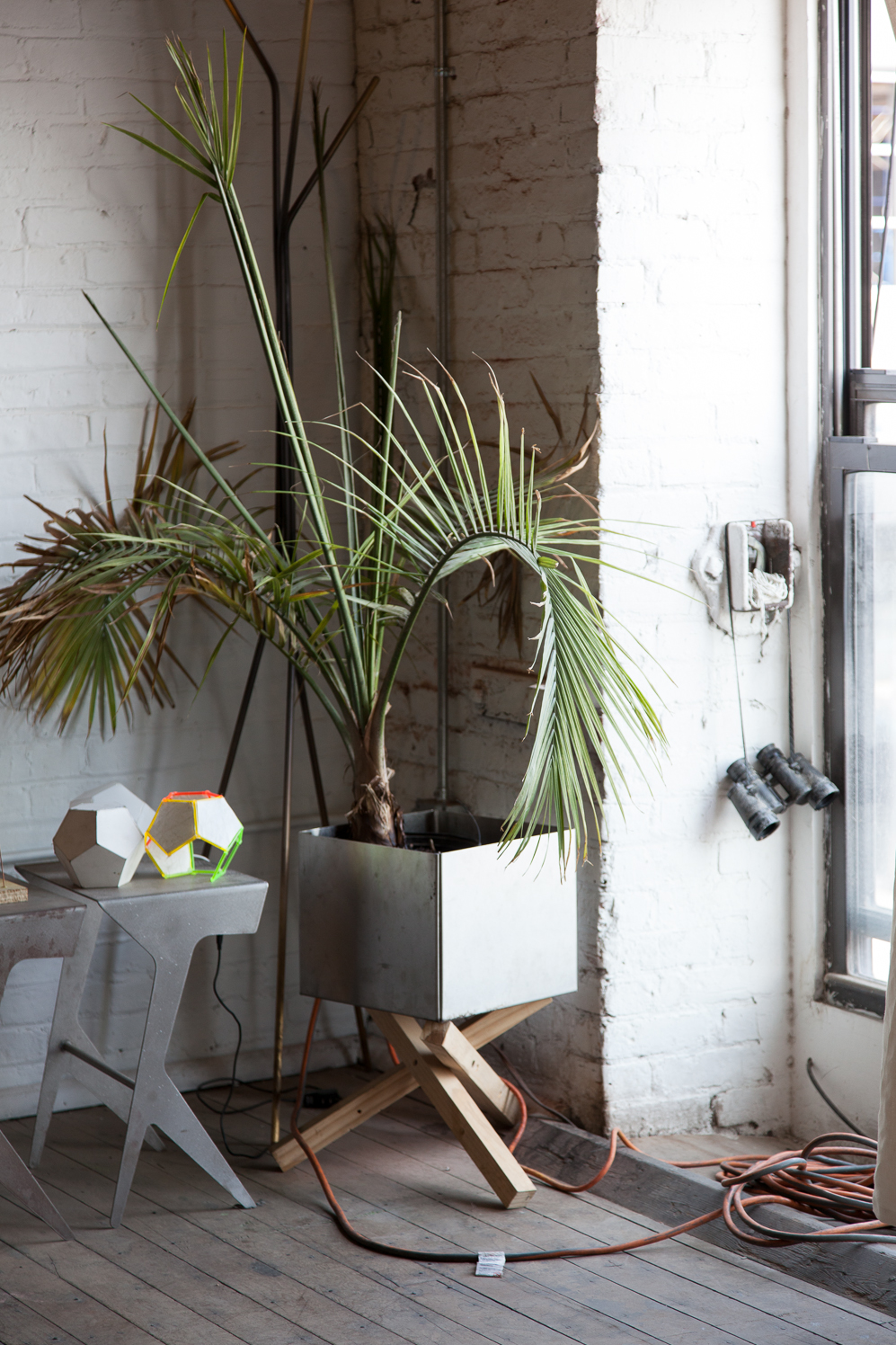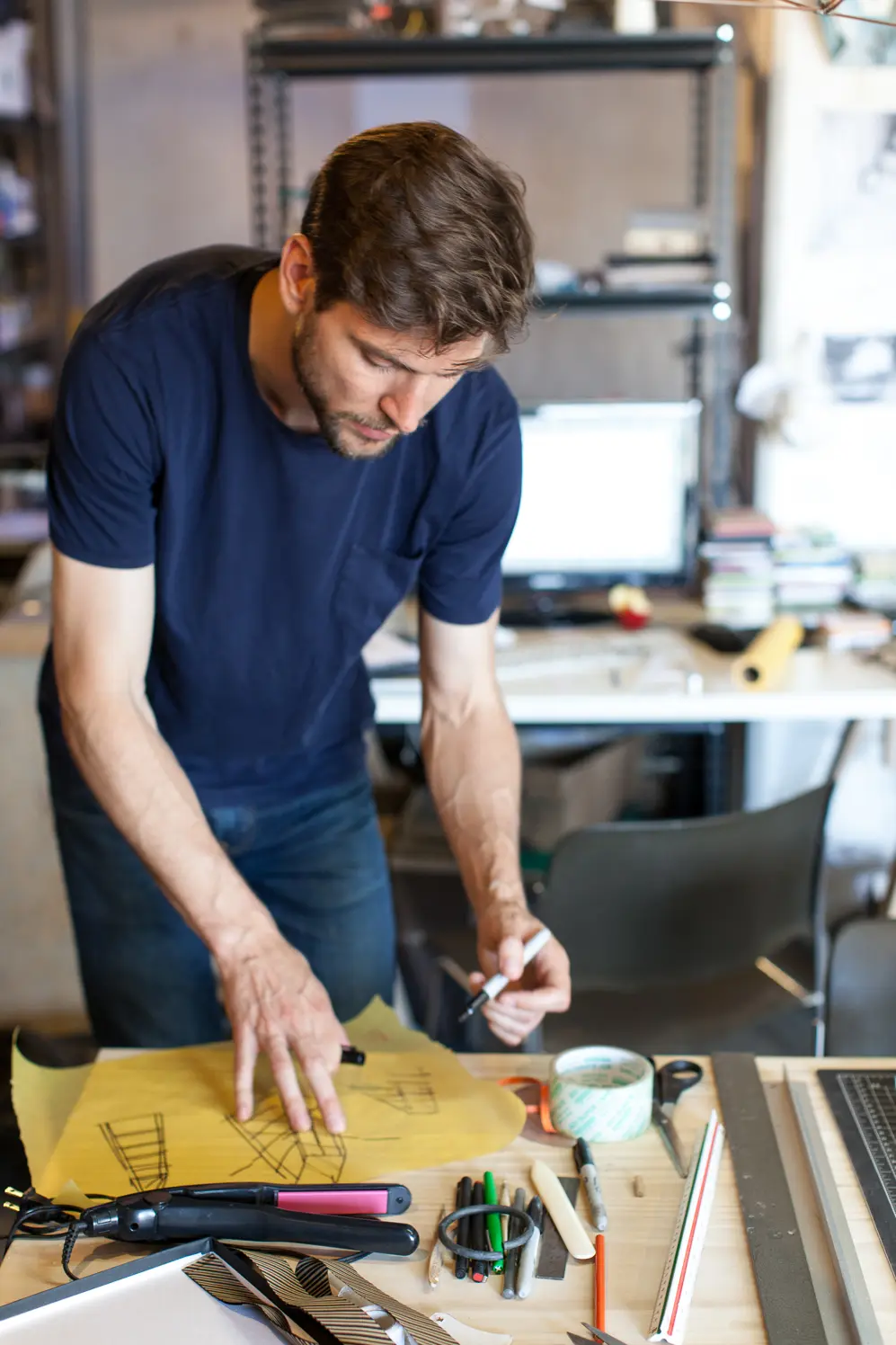Comprising an architect, an industrial designer, and a master fabricator, The Principals banded together to create products and environments that merge the new field of interactive design with good old-fashioned craftsmanship. Drew Seskunas first collaborated with Charles Constantine and Christopher Williams in 2011 on the Botox Trilogy, and they have been working together ever since. Honing their focus on developing new technologies, they maintain a crafted feel to their objects and installations.
Continuing production on their previous hit products like Bare Bones (For Billy Reid), as well as persuing their interactive installations at venues like MoMA PS1’s Warm Up Parties, The Principals have a relaxed studio environment, where skateboarding and hanging with friends is of utmost important. Drew invited us for a tour of The Principle’s Greenpoint studio to see the workshop in action, and get a closer look at their internationally acclaimed work.
Visit the FvF Online Shop for our exclusive collaboration on the Bare Bones Dominoes.



























Can you tell me about the formation of The Principals?
I’m an architect. I was working for this Belgian artist named Arne Quinze first in Belgium, then Berlin after graduate school. We worked on this big project called Bikini Berlin in Germany. I was there for a couple of years running the studio and the project, but towards the end of it when I was getting ready to close up shop, I didn’t know what I was going to do. A friend of mine who had a gallery in Berlin offered me an installation space, and one of my employees started talking about interactive design. I’d never done anything with it before, but got super into it. So that was the first project that’s on the website; the BotoxCloud. After that I thought I’d much rather do this than work on a building ever again!
Was this project what brought the group together?
Yeah, the Botox stuff really took me in another direction and I went right into another project, which the three of us all worked on together. Charles and I have known each other since we were four years old, and we went to graduate school together. He studied industrial design and I studied architecture. We kept in touch while I was in Europe after graduating, and were looking for something to collaborate on. He was working with Chris – our third partner – at a big industrial design studio with a huge fabrication studio.
Chris was the foreman of the floor, and Charles was a designer. Meanwhile I was trying to find someone to build the BotoxLamp project in Berlin. I had the concept but I couldn’t figure out how to make it. I ended up sending it to Charles and he said, “yeah we can definitely do that!” We actually made it in one night – from about eight at night when his boss left until six the next morning. We put it in a massive box, and I flew back to Berlin with it. It was pretty crazy. I showed it at the DMY in Berlin. That was the first time we all really worked together.
So this Botox series was the first collaboration for The Principals. Can you explain the concept?
The geometry was what really pulled us together, it lead me away from architecture and them away from industrial design. It was about studying geometry in space, how to take a flat plane and turn it into something more complex. And also how that relates to interaction and relational space and geometry. Each of the Botox projects were a little different in how it manifested those ideas. The first one was a very complex geometry but you could build it yourself, which helps to demystify the complexity. And also its faceted geometry was important to understand how the light was affecting the space and casting shadows.
The next one was really more about recreating a single object that was still interactive, but was a single thing that you could populate throughout a space – as opposed to propagating things that became a large mass. It was a totally self-contained object; a lamp.
Then the third one was part of a student workshop I did in collaboration with gallerist, Brice Delarue, and graphic designer, Lea Delion, in the Politecnico di Milano. There were 20 students and that installation was really about going back to basics, and analyzing interaction and how we understand architecture. Things like, what’s the simplest geometry you can make: a pyramid. Then we filled in light to define a space visually and tried to add complexity though the interaction of the light. In this project we looked back at historical precedents and placed these installations in a context, as opposed to just saying this is new, and futurist.
Do you think that was because you were working with students and had to create that lineage? Or was that just a natural progression in the trajectory of your work with this particular concept?
Both, I think. Definitely with the first few projects we were just seeing what we could do with it. Then we had a desire to look more critically at it, and really figure out what purpose it could serve. And then of course there was an academic aspect to working with students. I had to write a paper to be published and give a lecture, so I wanted to make sure it was solid. It was interesting to push myself and find out what was really interesting to me about architecture and map that out.
You are really working at the forefront of this interactive design field, but you don’t really fall within the clear definitions of an architecture or design firm. How do you see yourself, and how does that affect the way you move through the institutional part of those worlds?
It’s definitely difficult, but it’s totally intentional.
Well as an architect, a designer and fabricator, it seems like a kind of perfect trifecta.
Yes, we all come from our different backgrounds and for every project we each have a different level of input. We work together because we want to, but it has also proven to be really successful. The projects that we’ve done together are significantly better than the ones we’ve done on our own. We could probably make a lot more money doing a lot of different things, but that’s totally irrelevant to us. It sounds cliché, but we don’t like to conform to the standards of our respective fields.
How do you position yourself within those worlds? As partners that collaborate, you also have collaborations with other designers and stores or companies?
It’s all very organic. In the beginning everyone told us we had to be more specific about what we were doing – they looked at our business plans said “I don’t know what to do with this!” But we refused to be pigeon holed into one aspect or field, because it’s just boring!
I’m sure it opens up a lot of different avenues for the type of work you are able to do – like being able to design a very specific product like Bare Bones – but also these kind of amorphous installations.
Exactly, we recently worked on a prototype for PS1 Warm Ups. Here you can see the very first cosmic quilt model we made. The first time we installed it, it broke 20 minutes after we put it up! We were fixing it the whole time (laughs). Which is kind of cool, because you know you’re doing something ambitious when you’re pushing yourself beyond what is possible. People were still really into it, despite the fact that we were having to fix it all the time.
But that’s the cool thing. For me, I am not a mechanical engineer or a programmer, but I know enough about coding to get things done. The work is dependent on so many things. The better I get, the more I realize this. This is really cool because you can play with it. Especially when you hook up sensors and code them so that the mechanism reads it’s own actions and starts to respond to itself. The more you compound it, the bigger the animal grows, and the more it gets fucked up. But if you can anticipate that you can feed off of it, and the creation can start communicating with itself too.
What else is on the horizon for The Principals? Are you trying to go more towards these interactive installations, or more towards product design?
Each of us could answer that question differently on any given day. Knowing that, we just kind of go with what comes our way. We were really lucky to get a lot of offers in the first six months of having the company, but none of those clients were really aware of what else we were capable of doing. And now a lot of our clients want to work with us more and in different ways. We recently started working on a proposal for a series of pavilions for an old client. They’re really into interactive design and they like to nurture it. It’s tempting to want to become more of an artist in that realm, and only stick to gallery installations.
Can you talk about the Bare Bones Domino set project?
We really had to think about how someone holds a domino, how do you play, how far can we go with this? We had to straddle the line between making something beautiful that you wanted to hold, but that you could also play with. And thinking about that totally applies to our installations. I like it when a visitor is interested to stay and figure out how the installation works or what’s going on. You have to add layers of complexity for the viewer, you can’t just reveal it right away, but they have to get it quick enough so that they don’t walk out.
And then there are more ephemeral experiences?
Like in the Rain Room at MoMA. It’s cool, but it’s so simple! It’s a really simple concept executed really well. You go in and it’s raining where you’re not standing, and not raining where you’re standing. It’s very poetic, and I think it’s a perfect bridge to start getting people to treat these types of interactive installations like artworks.
The Principals seem to be producing increasingly much more complex installations.
Yes. And we are always trying to draw lines. With one of our latest concepts we are working with these platonic solids. The client’s brief was all about the idea of people getting together and learning. We were thinking of this famous painting by Raphael, The School of Athens, and the idea of architectural shapes creating a layering effect of space which impacts how knowledge is passed from one person to another.
Last year we worked on the Wave Dilfert project. We looked at a really basic architectural element and played with it: the barrel vault, one of the simplest enclosed spaces in architecture. This time we thought, why not start with platonic solids, but the ones that are all fucked up. We took them and started distorting them. So this is an icosahedron, sometimes people get stuck in what the purity of the form has to be, and they want to elevate it, so you’re sitting on a perfect piece of geometry, but that’s so fucking ridiculous! Do something with it! So that was how we started screwing with these things.
There is also the product aspect of your work?
Exactly, it’s super cheesy, but in the same respect if you really want as many people as possible to experience your work, you can’t say you have to “get art” to get this.
And in a way it’s the same thing as making the domino numbers legible. You have to make it accessible if you want people to “play”.
You’re really just trying to create an entry point to access this thing that might be initially intimidating to someone. You never know what people get about your work though (laughs).
That’s the biggest problem with any sort creative project. You can put out the game with the set of rules, and people are still going to do whatever they want.
That’s true! When we had the Bare Bones Tournament we used what we thought was a standard set of rules. But we had all this debate about how do people think dominoes is played correctly. We started playing with people all the time, getting ready to release the set. We ended up changing the rules to make it easier. But then of course we go in with the new rules and half the people were like, “what, I got used to the old rules!” So you can never anticipate that – almost definitely by putting the rules there, people are not going to want to follow them.
Have you ever hit a point where you might have to outsource aspects of your work?
We’ve thought about it. I guess ideally everyone wants to design a project that they don’t have to make, and make a lot of money. But that doesn’t really exist. What we really like is that we can immediately change course anytime if we want to. In the beginning we struggled so hard to try and define ourselves, but then we realized it was the worst thing we could do.
We focus on every single project and do it exactly how we would do it. I don’t think we would ever give up the shop, but ideally down the road we would love to have this office be a whole lot nicer – like a real office. Chas and I are from Baltimore and Chris is from South Brooklyn – we’re a little rough around the edges. We like to drink a lot, we like to hang out in our studio. We’re all friends. That’s our deal. This place is super dirty, you can’t put anything down without getting covered in dust. And we’re ok with that! We can fight it, but this is us! And it comes out in the studio, and that’s a wonderful thing.
Tell me a little more about the space, how long were you here?
A year and a half. It was totally barren and empty when we first got here, and over time it’s filled up and adapted. All this stuff just amounts. We built the skate ramp over winter because it was snowy outside and there was nowhere to skate. And once a week there would be people here skating, drinking, and projecting videos. It became a really fun hang out space.
The wood shop used to be right next to the office, but it slowly moved further away because it’s loud and dusty. We didn’t really know how to organize things at first. But when you’re working with people as a collective, that stuff just has to grow over time. Whenever there’s a lull in projects, we move things around and add things, and over time it’s become more and more professional. It becomes an extension of who you are.
Who are some other firms or studios in the field that you are interested in right now?
It’s really cool because a lot of people are doing stuff that they’d never been able to do before, and the result is great. What if an industrial designer does a light installation, or tries to be an architect, or an artist? It starts to evolve because everything is cross breeding. There’s a lot of bullshit, but everything has changed so significantly about the structure of companies and what people want now. Our generation of designers is willing to do anything and to take any opportunity that seems cool and really try to exploit it in a way that can be interesting to the design community as a whole. The result: you end up with these really amazing things that would never have developed before.
I really love Fort Standard. They’re good friends of ours. They have also done PS1 Warm Up. Everything they do is fantastic. Snarkitecture is an architect and an artist, and they do stuff that’s between art and architecture. I guess that could be considered more or less industrial design, but there’s some essence to their work that is beyond that and more about concept. They do it in a way that takes it to another level.
Where do you see The Principals going in the next five years, do you have a plan?
I think that’s counter intuitive for what we do (laughs).
Ok, do you have a plan for the space in the next five years?
Yes! We’re going to build another quarter pipe, so by the end of the summer you can skate both sides. That’s of primary importance right there. Everything else, I have no idea. It would be boring if I could say.
Drew many thanks for introducing the inner working of The Principals, we look forward to keeping updated on your future projects. To find out more see the studio’s website here.
Check out our collaboration with Drew and The Principals, new exclusive colorways of the Bare Bones Dominoes.
Photography: Fran Parente
Interview & Text: Olivia Murphy
